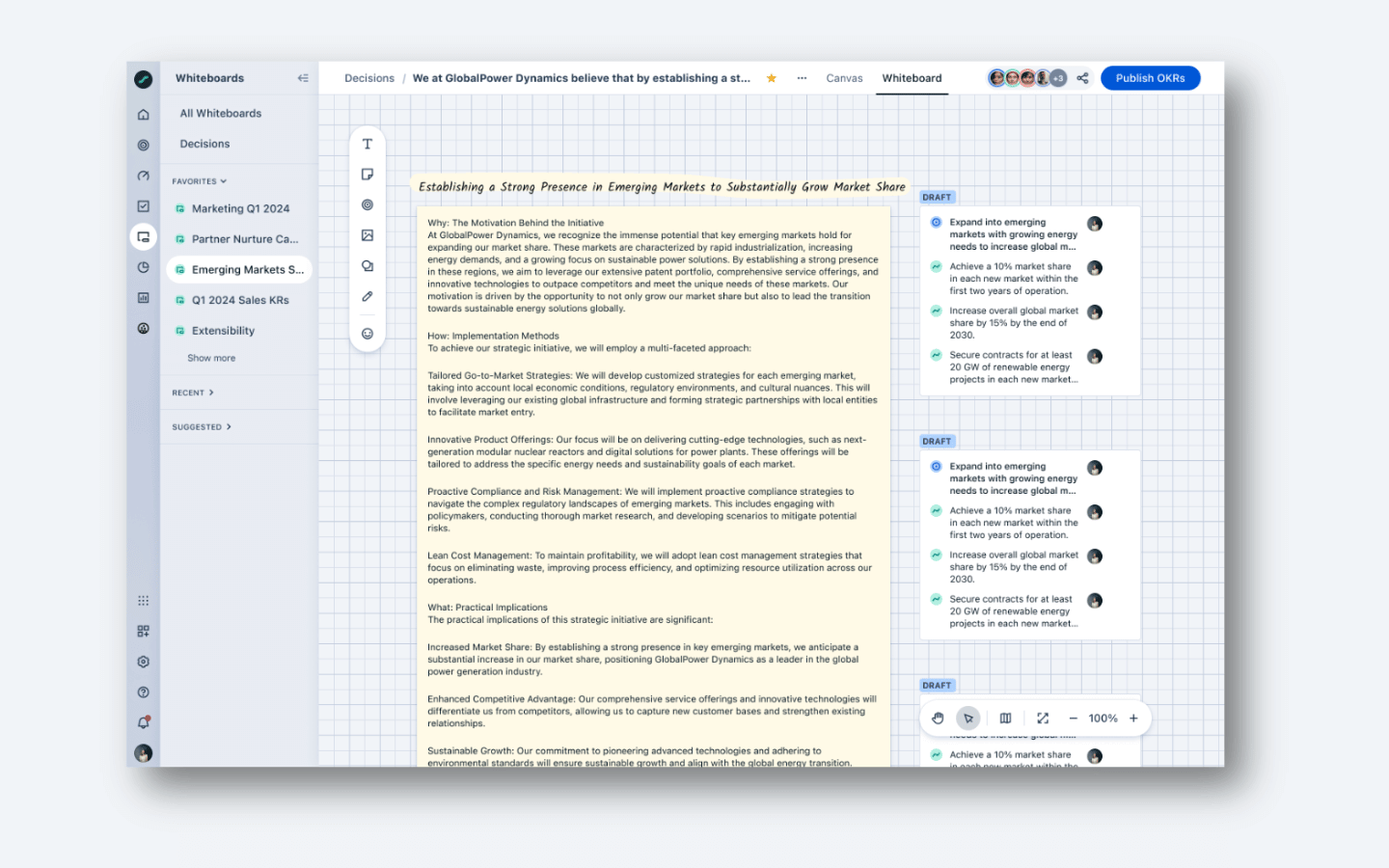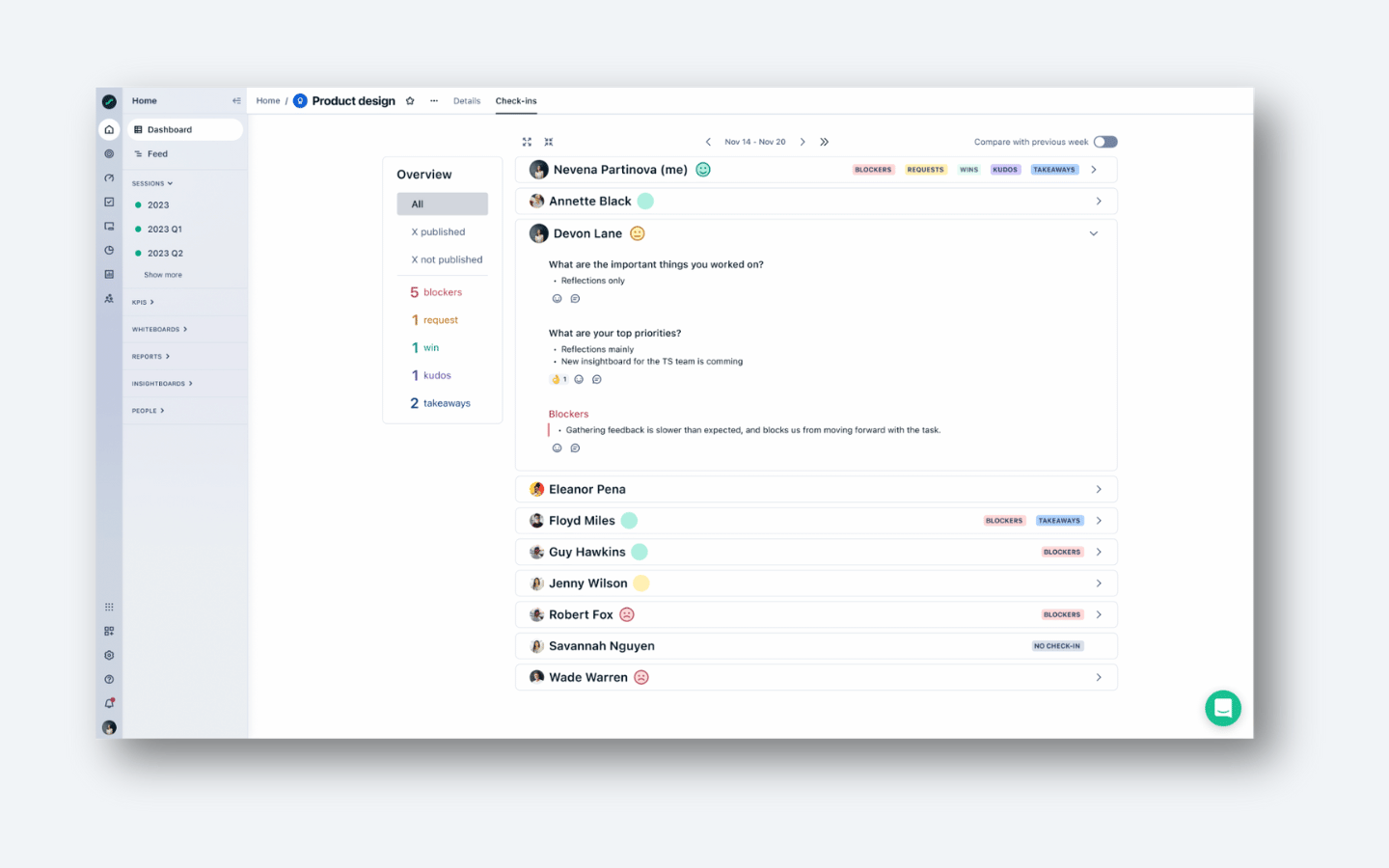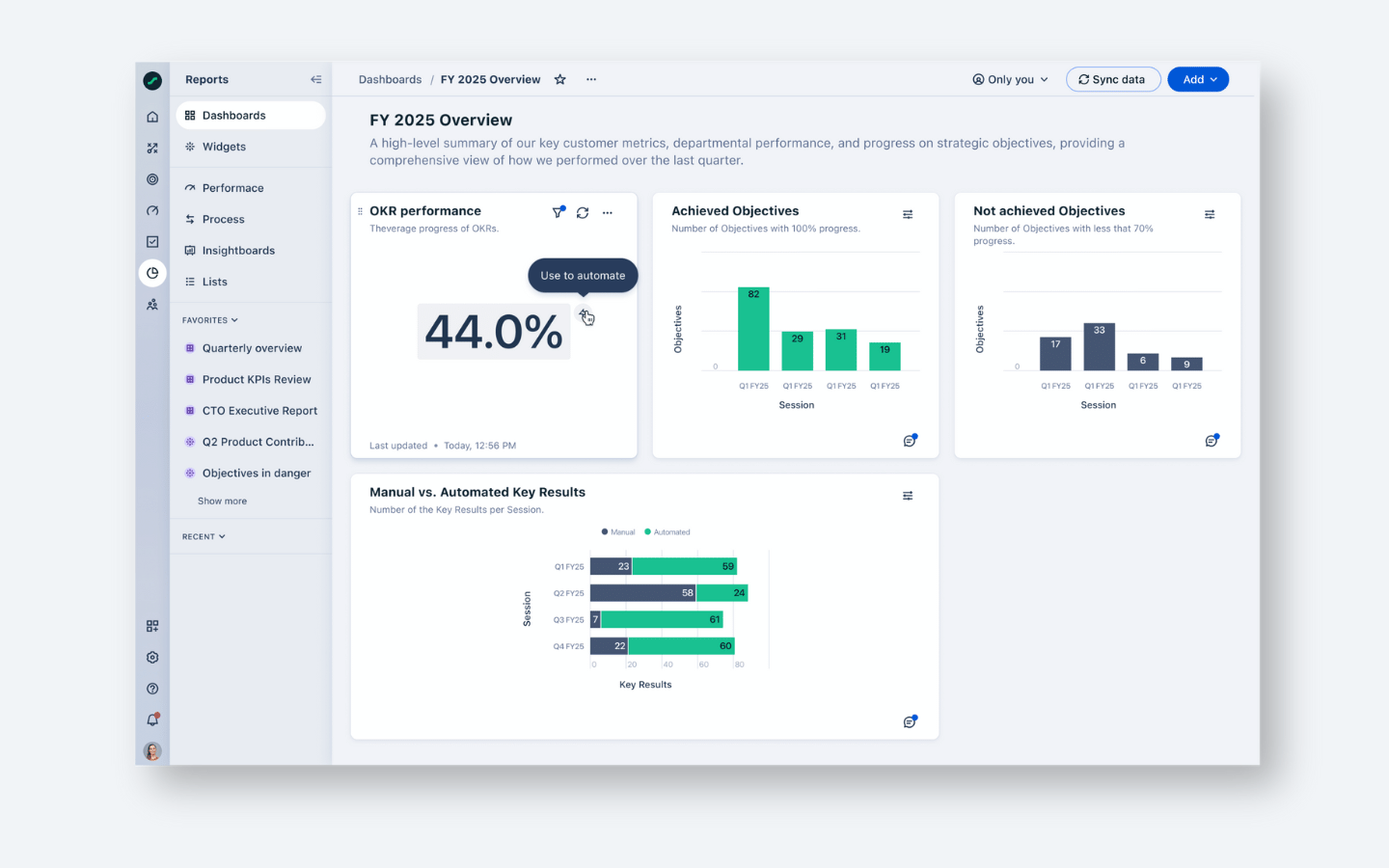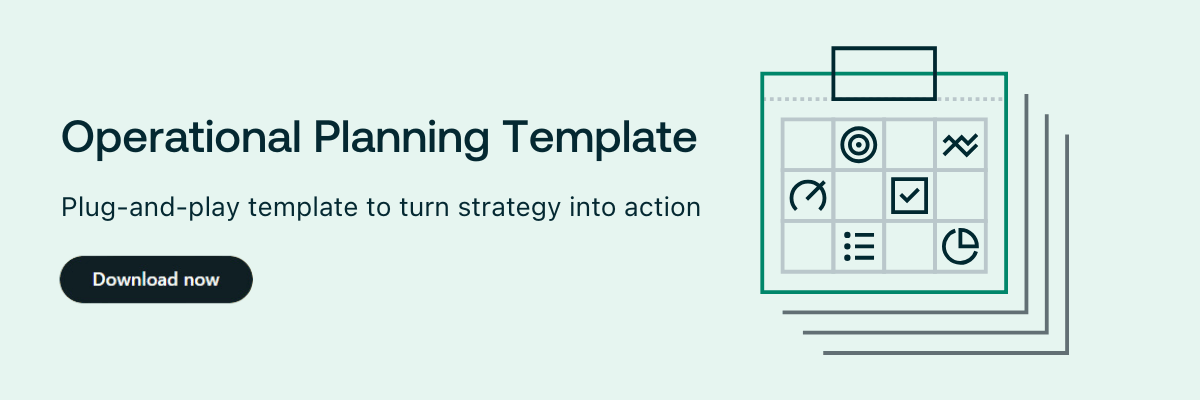Quantive is now part of WorkBoard. Get to know WorkBoard:
The CEO defines the vision. It's clear and aspirational. As a functional leader, you feel motivated by ambitious goals for growth, innovation, or efficiency. But here comes the reality: You start thinking about how to bring that vision to life. That's where operational planning comes in.
Operational planning is the process of translating high-level business strategy into clear, actionable steps at the departmental and team level. It outlines who does what, when, and how and translates long-term strategic goals into discrete daily processes.
While strategic planning sets the destination, operational planning maps the journey. The nuts-and-bolts process tells teams how to proceed on a day-to-day basis. Companies that excel at creating operations plans can break down their biggest organizational goals into actionable initiatives with structured budgets and meaningful metrics.
So, how do you build a strong operational plan that aligns with your company's goals? Let's examine the essentials, explore best practices, and examine the tools that make the process seamless.
What is operational planning?
Operational planning is the process of creating short-term steps and day-to-day plans at the department or team level. These practical plans work alongside large-scale business strategies, acting as roadmaps to achieve long-term strategic goals.
Effective operational planning allows stakeholders to figure out how they will allocate resources and assign personnel to specific tasks in the immediate future. Using metrics, such as Key Performance Indicators (KPIs), is a valuable part of the operational planning process, enabling teams to quantify their progress and set guideposts to larger corporate objectives.
Operational planning ensures that your organization never has any ambiguity about pursuing its strategy. Without an operations plan, it's not just hard to achieve your strategic goals. It's even harder to know if you're on the right track.
The path to successful operational planning
What does a good operational planning process look like? A few core ideas can keep your team on the right track. A step-by-step breakdown involves:
- Define your operational goals: Consult with key stakeholders to break down your company's strategic goals and broad objectives into team-level targets. These specific aims should drive impact and align with the higher-level strategic priorities. This will help you achieve operational goals over the long-run.
- Assign ownership of initiatives: Clarify responsibilities by turning those operational goals into objectives, each assigned to a specific team and given a timeline.
- Implement tracking and metrics: Use systems like KPIs to measure progress toward goals. Set up and choose metrics.
- Allocate resources: During project planning, ensure the right people, budget, and tools are in place to execute your plan effectively. This means ensuring these resources exist within the organization and allocating them to the teams needing them.
- Develop a risk mitigation plan: Identify potential challenges that may prevent the completion of your organization's goals and outline mitigation strategies for each. Team members should be briefed on these plans and be ready to implement them.
- Adapt and optimize in real-time: Be prepared to adjust the plan dynamically based on performance in order to meet your operational objectives. The KPIs established in step 3 will allow you to track performance actively rather than waiting for quarterly reviews.
What's the difference between strategic planning and operational planning?
Strategic and operational planning go hand in hand, but it's important to know the differences between the two. Operational planning serves as an enabler for strategic planning, but really excelling at it means approaching it on its own terms.
Key differences include:
- Time frame: Strategic planning is about long-term company goals. It typically comes together at the beginning of the year and sets the tone for the next 12 months, while operational plans involve short-term tactics needed to achieve each strategy stage.
- Scope: Your company's strategic plan applies to the broader, bigger picture. Strategies include goals like raising revenue by a certain amount over the next year or penetrating a new market. Operational plans are concerned with enabling those major objectives, and the KPIs reflect this.
It's easy to compare these concepts using an example: a SaaS company planning to expand its geographic reach.
- Strategic planning: The company wants to expand into Europe next year.
- Operational planning: The product team will create a localized launch plan while engineering adjusts compliance frameworks to accommodate the laws and marketing prepares a region-specific rollout campaign.
Considering these differences will help your people stay on track, whether engaging in strategic or operational planning.
What are examples of operational planning?
Whenever an organization hits all its marks on the way to achieving a major goal, you see operational planning in action. Here are some examples of how this process can play out in practice.
Example 1: A SaaS provider wants to improve customer response times and support efficiency. To accomplish these objectives, the business:
- Implements shift scheduling and workload balancing to ensure 24/7 support coverage.
- Develops a structured escalation plan for handling complex technical issues.
- Introduces automated chatbots and AI-driven tickets aiming to route customer requests efficiently.
- Creates a system for tracking operational KPIs such as first-response time, resolution rate, and customer satisfaction scores and implementing quick improvements.
Example 2: A major retail brand is launching a new product line across multiple locations. To ensure the success of the new items, it:
- Trains store associates on product features, sales strategies, and customer FAQs.
- Adjusts inventory distribution to ensure high-demand locations are stocked appropriately.
- Sets a promotional execution plan, including in-store marketing displays and customer engagement tactics.
- Tracks operational success metrics such as sell-through rates, foot traffic, and average order value.
Example 3: A B2B SaaS company is launching a new AI-powered feature and needs to ensure seamless, data-driven marketing execution. As part of the launch, the business:
- Defines campaign roles, allocating responsibilities to content, paid ads, social media, and email marketing teams.
- Sets campaign timelines, creating a structured roadmap with key milestones for content production, ad launch, and email sequences.
- Implements marketing automation, using a CRM and marketing platform to schedule emails, track engagement, and automate lead nurturing.
- Tracks real-time campaign KPIs, monitoring conversion rates, engagement metrics, and cost per lead.
What are 5 significant factors in an operational plan?
Every operational plan should be clear, actionable, and built for success. While your company's strategic goals shape the details, a few core elements ensure your plan drives results.
To keep execution on track, make sure your plan includes:
- Goals: These are the department-level objectives that the operational plan addresses. They should align with the overall corporate objectives for the year and contribute to achieving those overarching aims while being more granular about specific departments.
- Actions: An action plan contains the initiatives that specific owners will handle during the operational plan. You can set expectations before your team starts by giving timelines and expected outcomes for these initiatives.
- Metrics: Setting KPIs or other metrics to track progress toward objectives allows your people to take a data-driven approach to following the operational plan. The real-time metrics measurement shows whether progress is going as planned or if a pivot is necessary.
- Budget: Resource allocation at the operational planning stage is essential because it determines the plan is feasibility. This doesn't just mean setting a monetary budget but also accounting for factors such as employees' time and resource availability.
- Risks: By anticipating risks, you can build resilience into your operational plan. Defining likely risk factors, internal or external, and creating contingency plan measures prevents the plan from falling apart under strain.
An effective operational plan is a living document created collectively to help the company achieve its objectives. Every choice you make when creating such a plan should serve that greater good.
The benefits of operational planning with Quantive StrategyAI
Operational planning is not project or task management. It's much more complex. It's the way of turning strategy into seamless execution while maintaining adaptability. Quantive StrategyAI is your single source of truth for operational leaders, equipping them with AI-driven insights, dynamic goal tracking, and real-time performance visibility to execute multiple operational plans faster, mitigate risks proactively, and optimize operational performance.
Here's how you can elevate your operational planning with Quantive StrategyAI to meet your organization's vision:
Brainstorm the right operational plan collaboratively
Operational planning begins with breaking down high-level strategic objectives into actionable initiatives for each department. Quantive StrategyAI provides the framework to collaboratively refine, structure, and assign responsibilities—so execution is never an afterthought.
How Quantive StrategyAI helps:
- Collaborative whiteboards allow teams to brainstorm, map out dependencies, and refine priorities with tactical planning.
- AI-assisted operational goal creation ensures that every plan is aligned with strategic priorities and operational budget and backed by real-time data.
- Linking goals, tasks, and KPIs translates strategic intent into clear, measurable actions.
- Dynamic progress updates keep execution on course, ensuring plans evolve alongside business needs.

Track execution with dynamic, AI-driven insights
Execution tracking monitors progress and ensures continuous alignment, accountability, and proactive adjustments. Quantive StrategyAI eliminates static planning by delivering real-time visibility into operational performance, automated risk alerts, and AI-driven recommendations.
How Quantive StrategyAI helps:
- Real-time KPI dashboards provide up-to-the-minute insights on operational performance and desired outcomes.
- 170+ data integrations ensure execution tracking is tied directly to business metrics.
- AI-powered alerts notify leaders when operational goals deviate from expected performance.
- Weekly team check-ins keep alignment effortless—so execution never stalls.

Commit to rapid adaptation and continuous optimization
Operational agility is no longer optional. Organizations must adapt to shifting market conditions, supply chain disruptions, or evolving customer demands in real time to stay ahead.
How Quantive StrategyAI Helps:
- AI-powered scenario planning and analysis allow leaders to anticipate risks and proactively adjust execution plans.
- On-demand strategy evaluations provide data-backed insights on whether an operational plan needs refinement.
- AI-powered recommendations optimize efficiency by suggesting strategic pivots based on performance trends.

Why choose Quantive StrategyAI for operational planning?
Operational planning is the solid framework holding up your strategic plan. Quantive StrategyAI is the technology that keeps this framework strong:
- Real-time operational visibility — no more static and hard-to-keep-up-with spreadsheets.
- AI-assisted decision-making — get insights and recommendations, not just data.
- Automated goal workflows — reduce manual effort around goals and increase agility.
- Seamless cross-team collaboration — keep operations and strategy fully aligned.
Ready to excel in operational planning? Try Quantive StrategyAI for free.
We've created an easy-to-use template to help you follow the operational planning process and stick to best practices. This document lets you stay focused on completing your most closely held objectives. Download our operational planning template.






